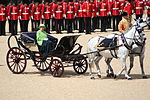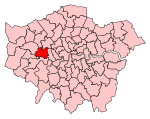South Acton is an area in Acton, West London, 6.4 miles (10.3 km) west of Charing Cross. At the 2001 census, Acton, comprising the wards of East Acton, Acton Central, South Acton and Southfield, had a population of 53,689 people.The area is dominated by the South Acton housing estate, a large public housing estate owned by Ealing Council. There are some 2,000 residential dwellings on the estate, covering approximately 25 hectares of land. These are accommodated in a range of principally medium to high rise blocks. The estate also provides shops, a youth club, a community centre, a nursery, school buildings and open space.
The area is well served by transport links. Acton Town, a major interchange for the District and Piccadilly lines, with links to Heathrow and the West End is on the western boundary. On the southern boundary is South Acton railway station, a London Overground station running north through to Stratford and south to Richmond. The site is bounded to the north by Acton High Street, to the south by the London Overground railway line, to the east by a Victorian residential neighbourhood and to the west by Bollo Lane and the tube lines. To the south east, on the other side of the railway line, lie the suburban residential areas of Acton Green and Bedford Park.
The estate and area is also particularly diverse. Historically, the area has been important for Irish Working Class immigrants, and recently this has been supplemented by Indian, Afro-Caribbean and Somali immigration. Currently the population is 52% white, including 5% of Irish descent, 24% Afro-Caribbean, 16% Asian, with the last 8% being of other ethnic origins. A great range of first languages other than English are spoken at the local school.Historically, the estate and the area has suffered from a poor reputation, in particular because of high levels of crime and drug dealing and use. However, recent efforts by the Council, Ealing Homes (the council's housing management company) and local residents have seen improvements in the area from 2005 onwards.Since 1999, the South Acton estate has been undergoing a regeneration which has resulted in significant improvements in both housing and community.





